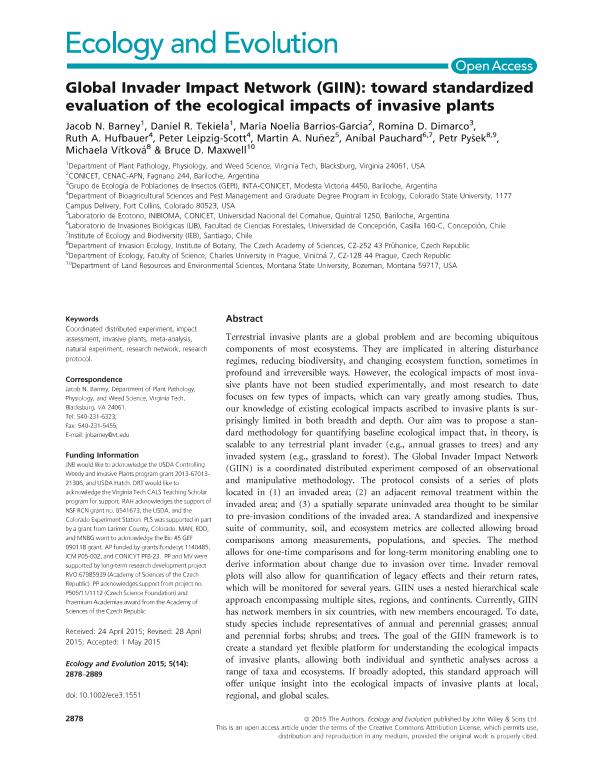Artículo
Global Invader Impact Network (GIIN): Toward standardized evaluation of the ecological impacts of invasive plants
Barney, Jacob N.; Tekiela, Daniel R.; Barrios Garcia Moar, Maria Noelia ; Dimarco, Romina Daniela
; Dimarco, Romina Daniela ; Hufbauer, Ruth A.; Leipzig Scott, Peter; Nuñez, Martin Andres
; Hufbauer, Ruth A.; Leipzig Scott, Peter; Nuñez, Martin Andres ; Pauchard, Aníbal; Pysek, Petr; Vítková, Michaela; Maxwell, Bruce D.
; Pauchard, Aníbal; Pysek, Petr; Vítková, Michaela; Maxwell, Bruce D.
 ; Dimarco, Romina Daniela
; Dimarco, Romina Daniela ; Hufbauer, Ruth A.; Leipzig Scott, Peter; Nuñez, Martin Andres
; Hufbauer, Ruth A.; Leipzig Scott, Peter; Nuñez, Martin Andres ; Pauchard, Aníbal; Pysek, Petr; Vítková, Michaela; Maxwell, Bruce D.
; Pauchard, Aníbal; Pysek, Petr; Vítková, Michaela; Maxwell, Bruce D.
Fecha de publicación:
07/2015
Editorial:
John Wiley and Sons Ltd
Revista:
Ecology and Evolution
ISSN:
2045-7758
Idioma:
Inglés
Tipo de recurso:
Artículo publicado
Clasificación temática:
Resumen
Terrestrial invasive plants are a global problem and are becoming ubiquitous components of most ecosystems. They are implicated in altering disturbance regimes, reducing biodiversity, and changing ecosystem function, sometimes in profound and irreversible ways. However, the ecological impacts of most invasive plants have not been studied experimentally, and most research to date focuses on few types of impacts, which can vary greatly among studies. Thus, our knowledge of existing ecological impacts ascribed to invasive plants is surprisingly limited in both breadth and depth. Our aim was to propose a standard methodology for quantifying baseline ecological impact that, in theory, is scalable to any terrestrial plant invader (e.g., annual grasses to trees) and any invaded system (e.g., grassland to forest). The Global Invader Impact Network (GIIN) is a coordinated distributed experiment composed of an observational and manipulative methodology. The protocol consists of a series of plots located in (1) an invaded area; (2) an adjacent removal treatment within the invaded area; and (3) a spatially separate uninvaded area thought to be similar to pre-invasion conditions of the invaded area. A standardized and inexpensive suite of community, soil, and ecosystem metrics are collected allowing broad comparisons among measurements, populations, and species. The method allows for one-time comparisons and for long-term monitoring enabling one to derive information about change due to invasion over time. Invader removal plots will also allow for quantification of legacy effects and their return rates, which will be monitored for several years. GIIN uses a nested hierarchical scale approach encompassing multiple sites, regions, and continents. Currently, GIIN has network members in six countries, with new members encouraged. To date, study species include representatives of annual and perennial grasses; annual and perennial forbs; shrubs; and trees. The goal of the GIIN framework is to create a standard yet flexible platform for understanding the ecological impacts of invasive plants, allowing both individual and synthetic analyses across a range of taxa and ecosystems. If broadly adopted, this standard approach will offer unique insight into the ecological impacts of invasive plants at local, regional, and global scales.
Archivos asociados
Licencia
Identificadores
Colecciones
Articulos(CCT - PATAGONIA NORTE)
Articulos de CTRO.CIENTIFICO TECNOL.CONICET - PATAGONIA NORTE
Articulos de CTRO.CIENTIFICO TECNOL.CONICET - PATAGONIA NORTE
Articulos(INIBIOMA)
Articulos de INST. DE INVEST.EN BIODIVERSIDAD Y MEDIOAMBIENTE
Articulos de INST. DE INVEST.EN BIODIVERSIDAD Y MEDIOAMBIENTE
Citación
Barney, Jacob N.; Tekiela, Daniel R.; Barrios Garcia Moar, Maria Noelia; Dimarco, Romina Daniela; Hufbauer, Ruth A.; et al.; Global Invader Impact Network (GIIN): Toward standardized evaluation of the ecological impacts of invasive plants; John Wiley and Sons Ltd; Ecology and Evolution; 5; 14; 7-2015; 2878-2889
Compartir
Altmétricas



